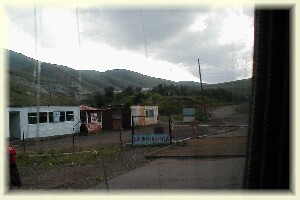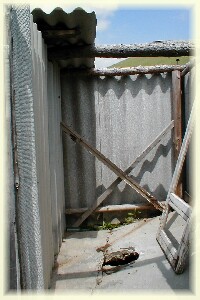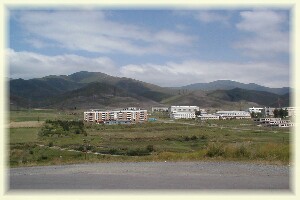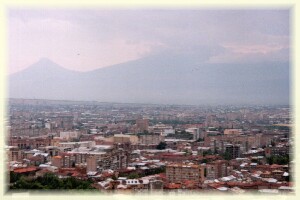 Today is August 15, the day our Georgian transit visa is going to expire and the Armenian visa is becoming effective.
So we have no other choice but to cross the border. According to Nasi, there's a bus leaving to Yerevan leaving at 8:15 in
the morning. We get up at 7 - everyone is still sound asleep, even Nasi, who sleeps on the veranda because the travelers have
occupied all the other rooms. We walk to Marjanishvilis square, but it's too early for the marshrutkas. We don't have much time,
and so we decide to take a taxi. After a short haggle about the fare, the driver takes us to Ortachala bus terminal.
Some men approach and offer taxis and marshrutkas to Yerevan. No way. We insist on taking the regular bus, one of the familiar old,
yellow Ikarus buses made in Hungary. Getting tickets for the bus and some food for the ride takes a few minutes only. The driver
wants to see our Armenian visa - no visa, no ride. Thank god we've got one, and so we can take our seats. Inside the bus, it's
incredibly narrow. The bus leaves on time and we even proceed rather quickly.
Looking out the window is very interesting and reminds me on Russia again. Almost all houses in the villages are completely made of
wood. The roads are muddy and full of more or less deep holes. Farmer's wives with weather-tanned faces, wearing scarves,
walk the roads. After a while, we leave the broad valley at Kasreti. From there, the road spirals up the sparsely populated mountains.
One thing is for sure - Hungary is a flat country, and Hungarian Ikarus buses are not made for mountains, especially not when they're
full. From now on, it wouldn't make a difference whether we walk or sit on the bus.
Today is August 15, the day our Georgian transit visa is going to expire and the Armenian visa is becoming effective.
So we have no other choice but to cross the border. According to Nasi, there's a bus leaving to Yerevan leaving at 8:15 in
the morning. We get up at 7 - everyone is still sound asleep, even Nasi, who sleeps on the veranda because the travelers have
occupied all the other rooms. We walk to Marjanishvilis square, but it's too early for the marshrutkas. We don't have much time,
and so we decide to take a taxi. After a short haggle about the fare, the driver takes us to Ortachala bus terminal.
Some men approach and offer taxis and marshrutkas to Yerevan. No way. We insist on taking the regular bus, one of the familiar old,
yellow Ikarus buses made in Hungary. Getting tickets for the bus and some food for the ride takes a few minutes only. The driver
wants to see our Armenian visa - no visa, no ride. Thank god we've got one, and so we can take our seats. Inside the bus, it's
incredibly narrow. The bus leaves on time and we even proceed rather quickly.
Looking out the window is very interesting and reminds me on Russia again. Almost all houses in the villages are completely made of
wood. The roads are muddy and full of more or less deep holes. Farmer's wives with weather-tanned faces, wearing scarves,
walk the roads. After a while, we leave the broad valley at Kasreti. From there, the road spirals up the sparsely populated mountains.
One thing is for sure - Hungary is a flat country, and Hungarian Ikarus buses are not made for mountains, especially not when they're
full. From now on, it wouldn't make a difference whether we walk or sit on the bus.
|
Picture: Border crossing between Georgia and Armenia. First impression!? |
 The whole procedure took less than half an hour, and so we can soon continue. The road crosses a large plateau. On the other side we
can see a massice mountain range. The first thing we notice is that there are much less trees than in Georgia. After two hours
on a really bad road we enter the mountains again. There, we stop at a place with some makeshift houses (so far, everything seems to be
makeshift). All passengers get off the bus, and so do we. The weather is fantastic and the landscape just great. Which cannot be
said about the toilets. However, that's a part of the deal... The bus driver is having a shashlyk with some other guys sitting in a
small cabin. There's even an old but working mechanical water pump so that the passengers can refresh.
The whole procedure took less than half an hour, and so we can soon continue. The road crosses a large plateau. On the other side we
can see a massice mountain range. The first thing we notice is that there are much less trees than in Georgia. After two hours
on a really bad road we enter the mountains again. There, we stop at a place with some makeshift houses (so far, everything seems to be
makeshift). All passengers get off the bus, and so do we. The weather is fantastic and the landscape just great. Which cannot be
said about the toilets. However, that's a part of the deal... The bus driver is having a shashlyk with some other guys sitting in a
small cabin. There's even an old but working mechanical water pump so that the passengers can refresh.
|
Picture: Armenia's greatest restrooms I
|
We are the one and only foreigners and therefore the main attraction on the bus. Now that we've crossed the border,
people come to us asking this and that. A gold-spectacled woman, around fifty years old, is asking about my profession.
I answer that I work as a teacher, which makes her happy. She's a teacher as well, calls me a colleague and starts talking
about the good ol' times. And about our plans in Armenia. What we are going to see. Where we are going to go. Where we are
planning to stay. Nasi in Tbilisi has provided us with an address in Yerevan, that's all we have. Now we are getting somewhere!
She says that we can stay with her if we want. And that she doesn't want to beg for money,
but a small payment would be nice. Which is just fair. However, as for the moment I refuse. She's a bit too talkative and somehow
suspicious.
 She's not giving up so easily and starts talking about the accommodation offer again. The two of us, three nights...in that
case, US$ 100 would be enough! Enough!? Yes, I believe that this would be enough for her. To say it with other words,
that's way too much. And so I finally refuse. In revenge for her "nice" offer, we let her try black natto - a Japanese snack, made of
rotten beans. Not suitable for most non-Japanese. The Armenian gold-spectacled teacher can tell you about it!
After more than an hour, our satisfied bus driver continues driving. Now we know almost everyone on the bus, with people smiling
at us occasionally.
She's not giving up so easily and starts talking about the accommodation offer again. The two of us, three nights...in that
case, US$ 100 would be enough! Enough!? Yes, I believe that this would be enough for her. To say it with other words,
that's way too much. And so I finally refuse. In revenge for her "nice" offer, we let her try black natto - a Japanese snack, made of
rotten beans. Not suitable for most non-Japanese. The Armenian gold-spectacled teacher can tell you about it!
After more than an hour, our satisfied bus driver continues driving. Now we know almost everyone on the bus, with people smiling
at us occasionally.
In Armenian towns and villages we soon notice that almost all bigger buildings are made of light reddish-brown tuff. Except for
the city of Spitak. In 1988, a desastrous earthquake levelled the entire city. Parts of it have been rebuilt, with slighly more diversity
here and there.
|
Picture: Typical small town in Armenia
|
After some kilometers, the bus leaves the road from Spitak to Gyumri (formerly known as Leninakan) and follows a serpentine
into the mountains. Not one single tree can be seen. The endless green of the grass, dotted with carpets of red and purple flowers,
the blue of the sky and the white clouds touching the mountains form an incredible picture. I'm almost suffering the Stendhal-syndrome.
Behind the pass we can see snow-covered Mt Aragats or at least parts of it - unfortunately, most of this massive summit
is hiding behind a thick bank of clouds. After a few more hours, the landscape starts to turn into a real steppe. We are getting closer
to the capital of Armenia. Before we enter the town, the road passes a long gorge. At around half past five, after more than
nine hours on the bus, we finally arrive. The bus terminal is outside the centre. Since we have nothing better to do, we first walk
into the wrong direction. A few minutes later we are getting sick of this, walk back und go to the city centre. Indeed, huge Mt Ararat
can be seen from Yerevan! But we can only see the faint outline of this majestic mountain through the mist.
 The city centre is separated from the southern and western suburbs by a deep gorge. The first thing we notice are the
numerous construction sites. Many streets and buildings are under construction, the entire city seems to be in transition.
But first we need some cash. Luckily we find a bank with an ATM near Republic Square in the heart of Yerevan. And a
nice café, where we can finally have a short rest after the long and exhausting bus ride. While sipping a coffee, we
can enjoy the view of the Republic Square, a huge round square, surrounded by four quarter-circle shaped palace-like
buildings made of tuff of course. The National Art Gallery faces the square as well. Occasionally, some Ladas and here and there
a Mercedes Benz or BMW are speeding across the square.
The city centre is separated from the southern and western suburbs by a deep gorge. The first thing we notice are the
numerous construction sites. Many streets and buildings are under construction, the entire city seems to be in transition.
But first we need some cash. Luckily we find a bank with an ATM near Republic Square in the heart of Yerevan. And a
nice café, where we can finally have a short rest after the long and exhausting bus ride. While sipping a coffee, we
can enjoy the view of the Republic Square, a huge round square, surrounded by four quarter-circle shaped palace-like
buildings made of tuff of course. The National Art Gallery faces the square as well. Occasionally, some Ladas and here and there
a Mercedes Benz or BMW are speeding across the square.
It's already quite late, and so we decide to look for the address we've got from Nasi. Another private accommodation.
Halfway, a young Armenian is joining us, starting a conversation in rather poor English. He offers to help us finding the
address. Without him, it would have taken quarter an hour, but thanks to him it's only 15 minutes. He's not of much help
and doesn't really have a clue. We can find the right street and the number quite fast, but the building has three entrances.
Of course, #3 is the correct place. A friendly woman opens the door, but she already hosts another traveler, from Hungary,
and she cannot host another person. But she sends us to another person living next door after making a phone call. There
seems to be a small network, and the network is working.
|
Picture: Centre of Yerevan and Mt Ararat (in Turkey) in the back
|
The young Armenian is still with us, jumping around excitedly. A small woman, around 50 years old and wearing large glasses,
opens the door. She welcomes us friendly and shows us around the apartment. And she's talking without the shortest
break. Our new Armenian friend is still with us - what is he doing here!? The woman doesn't even seem to bother.
Something is not okay, and after a few minutes I realize what it is. He's annoying. He doesn't notice that I can well
get along with my Russian and that I know what I'm doing. The woman asks something in Russian. I want to reply. As soon as
I open my mouth, he's trying to translate the question into English. Yes, he's friendly but he's a real nuisance. To get rid of
him (how cruel), we agree on meeting again two days later. The apartment is quite big and technically it's a gallery. There are
hundreds of pictures of all formats, styles and motifs. From expressionism to pointilism, from still life to portrait,
from propaganda to ikons - you name it. Her husband is ? was ? a popular painter, and his pictures can even be found in the
National Art Gallery.
Our host is talking very, very quickly. In Russian, of course. While she's explaining everything, I sometimes have difficulties in following
her. And there's a lot to be explained: Especially the part about the water is quite tricky. There's a self-made water tank in
her bathroom, which can even be heated. But we shouldn't use it when there's "state water" (lit. translated). So we have to
check for "state water" first. It's even possible to have a hot shower straight from the tank.
After an hour or so she hands out the apartment keys, so we can leave whenever we want. We can also use the kitchen and
everything else. Before we can leave, she explains the door lock three times...
Now we are really hungry. The apartment is opposite the opera, and in front of the opera is a beautiful park with neon-lit
open air bars and restaurants. I start to like this city - a great place to be. And completely different to Tbilisi.
Especially the atmosphere in the park is very relaxed. However, it's already late in the evening, so there's not much to eat.
A strange adaption of a hamburger, salad, beer and one very tasty Armenian cognac is setting us back 3500 Dram, around
€ 7. Quite a lot, but we are in the heart of the Armenian capital in a rather chic bar.
At night, a refreshing thunderstorm washes the dusty air. And so we end up sitting on the balcony enjoying the lightning and the
thunder. Our first impression of Yerevan can't be better - the town is a real surprise and a very nice place to spend a couple
of days. And staying with Anait, our host, is just fun.
|
 Today is August 15, the day our Georgian transit visa is going to expire and the Armenian visa is becoming effective.
So we have no other choice but to cross the border. According to Nasi, there's a bus leaving to Yerevan leaving at 8:15 in
the morning. We get up at 7 - everyone is still sound asleep, even Nasi, who sleeps on the veranda because the travelers have
occupied all the other rooms. We walk to Marjanishvilis square, but it's too early for the marshrutkas. We don't have much time,
and so we decide to take a taxi. After a short haggle about the fare, the driver takes us to Ortachala bus terminal.
Some men approach and offer taxis and marshrutkas to Yerevan. No way. We insist on taking the regular bus, one of the familiar old,
yellow Ikarus buses made in Hungary. Getting tickets for the bus and some food for the ride takes a few minutes only. The driver
wants to see our Armenian visa - no visa, no ride. Thank god we've got one, and so we can take our seats. Inside the bus, it's
incredibly narrow. The bus leaves on time and we even proceed rather quickly.
Looking out the window is very interesting and reminds me on Russia again. Almost all houses in the villages are completely made of
wood. The roads are muddy and full of more or less deep holes. Farmer's wives with weather-tanned faces, wearing scarves,
walk the roads. After a while, we leave the broad valley at Kasreti. From there, the road spirals up the sparsely populated mountains.
One thing is for sure - Hungary is a flat country, and Hungarian Ikarus buses are not made for mountains, especially not when they're
full. From now on, it wouldn't make a difference whether we walk or sit on the bus.
Today is August 15, the day our Georgian transit visa is going to expire and the Armenian visa is becoming effective.
So we have no other choice but to cross the border. According to Nasi, there's a bus leaving to Yerevan leaving at 8:15 in
the morning. We get up at 7 - everyone is still sound asleep, even Nasi, who sleeps on the veranda because the travelers have
occupied all the other rooms. We walk to Marjanishvilis square, but it's too early for the marshrutkas. We don't have much time,
and so we decide to take a taxi. After a short haggle about the fare, the driver takes us to Ortachala bus terminal.
Some men approach and offer taxis and marshrutkas to Yerevan. No way. We insist on taking the regular bus, one of the familiar old,
yellow Ikarus buses made in Hungary. Getting tickets for the bus and some food for the ride takes a few minutes only. The driver
wants to see our Armenian visa - no visa, no ride. Thank god we've got one, and so we can take our seats. Inside the bus, it's
incredibly narrow. The bus leaves on time and we even proceed rather quickly.
Looking out the window is very interesting and reminds me on Russia again. Almost all houses in the villages are completely made of
wood. The roads are muddy and full of more or less deep holes. Farmer's wives with weather-tanned faces, wearing scarves,
walk the roads. After a while, we leave the broad valley at Kasreti. From there, the road spirals up the sparsely populated mountains.
One thing is for sure - Hungary is a flat country, and Hungarian Ikarus buses are not made for mountains, especially not when they're
full. From now on, it wouldn't make a difference whether we walk or sit on the bus.
 The whole procedure took less than half an hour, and so we can soon continue. The road crosses a large plateau. On the other side we
can see a massice mountain range. The first thing we notice is that there are much less trees than in Georgia. After two hours
on a really bad road we enter the mountains again. There, we stop at a place with some makeshift houses (so far, everything seems to be
makeshift). All passengers get off the bus, and so do we. The weather is fantastic and the landscape just great. Which cannot be
said about the toilets. However, that's a part of the deal... The bus driver is having a shashlyk with some other guys sitting in a
small cabin. There's even an old but working mechanical water pump so that the passengers can refresh.
The whole procedure took less than half an hour, and so we can soon continue. The road crosses a large plateau. On the other side we
can see a massice mountain range. The first thing we notice is that there are much less trees than in Georgia. After two hours
on a really bad road we enter the mountains again. There, we stop at a place with some makeshift houses (so far, everything seems to be
makeshift). All passengers get off the bus, and so do we. The weather is fantastic and the landscape just great. Which cannot be
said about the toilets. However, that's a part of the deal... The bus driver is having a shashlyk with some other guys sitting in a
small cabin. There's even an old but working mechanical water pump so that the passengers can refresh.
 She's not giving up so easily and starts talking about the accommodation offer again. The two of us, three nights...in that
case, US$ 100 would be enough! Enough!? Yes, I believe that this would be enough for her. To say it with other words,
that's way too much. And so I finally refuse. In revenge for her "nice" offer, we let her try black natto - a Japanese snack, made of
rotten beans. Not suitable for most non-Japanese. The Armenian gold-spectacled teacher can tell you about it!
After more than an hour, our satisfied bus driver continues driving. Now we know almost everyone on the bus, with people smiling
at us occasionally.
She's not giving up so easily and starts talking about the accommodation offer again. The two of us, three nights...in that
case, US$ 100 would be enough! Enough!? Yes, I believe that this would be enough for her. To say it with other words,
that's way too much. And so I finally refuse. In revenge for her "nice" offer, we let her try black natto - a Japanese snack, made of
rotten beans. Not suitable for most non-Japanese. The Armenian gold-spectacled teacher can tell you about it!
After more than an hour, our satisfied bus driver continues driving. Now we know almost everyone on the bus, with people smiling
at us occasionally.
 The city centre is separated from the southern and western suburbs by a deep gorge. The first thing we notice are the
numerous construction sites. Many streets and buildings are under construction, the entire city seems to be in transition.
But first we need some cash. Luckily we find a bank with an ATM near Republic Square in the heart of Yerevan. And a
nice café, where we can finally have a short rest after the long and exhausting bus ride. While sipping a coffee, we
can enjoy the view of the Republic Square, a huge round square, surrounded by four quarter-circle shaped palace-like
buildings made of tuff of course. The National Art Gallery faces the square as well. Occasionally, some Ladas and here and there
a Mercedes Benz or BMW are speeding across the square.
The city centre is separated from the southern and western suburbs by a deep gorge. The first thing we notice are the
numerous construction sites. Many streets and buildings are under construction, the entire city seems to be in transition.
But first we need some cash. Luckily we find a bank with an ATM near Republic Square in the heart of Yerevan. And a
nice café, where we can finally have a short rest after the long and exhausting bus ride. While sipping a coffee, we
can enjoy the view of the Republic Square, a huge round square, surrounded by four quarter-circle shaped palace-like
buildings made of tuff of course. The National Art Gallery faces the square as well. Occasionally, some Ladas and here and there
a Mercedes Benz or BMW are speeding across the square.